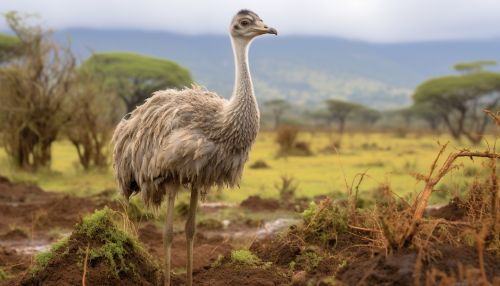Rhea (bird)
Taxonomy and Evolution
The Rhea is a member of the family Rheidae, which is part of the order Struthioniformes, also known as ratites. Ratites are a group of flightless birds that also includes the emu, ostrich, and kiwi. The Rheidae family consists of two extant species: the Greater Rhea (Rhea americana) and the Lesser Rhea (Rhea pennata). The exact evolutionary history of these birds is still a topic of debate among scientists, but it is generally agreed that they diverged from other ratites during the Cretaceous period, around 80 million years ago.


Physical Characteristics
Rheas are large, flightless birds, with the Greater Rhea reaching heights of up to 1.7 meters (5.6 ft) and weights of up to 40 kilograms (88 lb). They have long, powerful legs adapted for running and large, broad wings that, while not capable of flight, are used for balance and changing direction at high speeds. Their feathers are loose and hair-like, differing from the tightly-bound plumage seen in flying birds. The color of their feathers varies from grey to brown, with males typically darker than females.
Habitat and Distribution
Rheas are native to South America and can be found across a wide range of habitats, from the pampas of Argentina to the scrub forests of Brazil. They are highly adaptable and can thrive in both open grasslands and dense forests. Despite their adaptability, habitat loss due to agriculture and hunting for their meat and feathers have led to a decline in their populations, particularly for the Lesser Rhea.
Diet and Behavior
Rheas are omnivores, feeding on a variety of plants, fruits, insects, and small vertebrates. They have a unique feeding strategy known as 'flush-and-chase', where they scare prey out of hiding and then pursue it at high speeds. They are social birds, often forming large flocks of up to 50 individuals outside of the breeding season. During the breeding season, males become solitary and territorial, building nests and incubating the eggs of multiple females.
Reproduction and Life Cycle
Rheas have a unique reproductive system where the males take on the majority of the parental duties. After mating, the female will lay her eggs in the male's nest and then leave to find another mate. The male will then incubate the eggs for around 40 days, during which time he does not eat, drink, or defecate. Once the chicks hatch, the male will care for them until they are fully grown, teaching them to feed and protecting them from predators.
Conservation Status
Both species of Rhea are currently listed as Near Threatened by the International Union for Conservation of Nature (IUCN). The main threats to their survival are habitat loss due to agriculture and hunting for their meat and feathers. Conservation efforts are currently focused on habitat protection and the establishment of protected areas.
